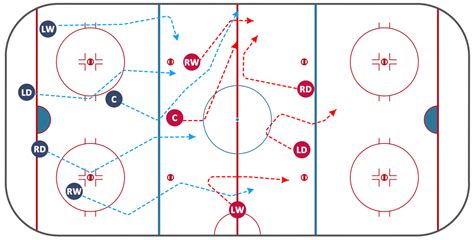Explore the science behind hockey pucks, from materials and design to temperature effects and innovations, enhancing your understanding of gameplay strategies.Hockey, a game celebrated for its speed and skill, hinges on a small yet crucial component: the hockey puck. While the fast-paced action and athletic prowess of players often steal the spotlight, understanding the science behind hockey pucks is equally important for players, coaches, and fans alike. This article delves into the materials that make up hockey pucks, the intricate design features that enhance performance, and the effects of temperature on how they behave during play. We will explore the innovations shaping the future of hockey pucks and how their weight and size can influence game strategy. Whether you’re an avid player looking to gain an edge or a passionate fan wanting to deepen your appreciation for the game, this comprehensive guide will equip you with everything you need to know about the science behind hockey pucks.
Understanding The Materials Used In Hockey Pucks
The materials used in the construction of hockey pucks play a crucial role in determining their performance on the ice. Traditionally, hockey pucks are made from vulcanized rubber, which gives them the desired hardness and resilience necessary for the fast-paced game.
Vulcanized rubber is created through a chemical process that enhances the material’s elasticity and durability. This is essential as hockey pucks need to withstand high-impact collisions during play without deforming or breaking. The unique properties of this material help ensure that pucks can slide smoothly across the ice while maintaining a predictable trajectory.
In addition to traditional rubber, manufacturers have explored other materials in their designs. For example, some pucks contain additives or are made from composite materials to enhance specific performance characteristics such as weight, grip, or visibility. These innovations contribute to improving how players interact with the puck, ultimately affecting gameplay.
Another critical aspect is the puck’s weight, which is standardized at 170 grams (6 ounces) according to regulations. This weight ensures that the puck travels at the desired speed and can be handled effectively by players of all skill levels. Understanding the materials and their properties is integral to appreciating the science behind hockey pucks and their performance on the ice.
The Science Of Puck Design And Aerodynamics
The design of hockey pucks is a fascinating area of study that brings together physics, engineering, and sports science. Understanding the science behind puck design and aerodynamics can significantly enhance a player’s performance and a team’s strategy on the ice.
One major aspect of puck design is its shape and surface texture. A standard hockey puck is designed to be a perfect cylinder, which allows for optimal rolling on the ice surface. The smooth surface minimizes friction, enabling the puck to glide swiftly across the rink. However, the addition of specific textures can influence how the puck interacts with air and ice, which can impact its speed and accuracy.
Aerodynamics plays a crucial role in the flight of the puck. As it travels through the air, the airflow around it is shaped by its velocity and rotational speed. The design factors such as thickness and the flatness of the edges can affect how the puck cuts through the air. For example, a puck that is too thick may face increased drag, slowing it down significantly.
Furthermore, the weight distribution within the puck affects its trajectory. Pucks are typically designed to have a uniform weight which aids in maintaining a consistent path when shot. Advanced manufacturing technologies now allow for experimentation with different weight distributions, which can result in a puck that is designed specifically for high-speed play or for controlled passing under varying conditions.
Another key consideration in puck design is how well it can withstand high-velocity impacts without deforming. This is where materials science comes into play. By utilizing materials that combine durability with the right level of elasticity, manufacturers can create pucks that not only survive the harsh impacts of the game but also maintain their shape and performance over time.
the science behind hockey puck design and aerodynamics encompasses a combination of structural engineering, material science, and physics, making it a critical area of study for improving gameplay. Understanding these elements can provide players and coaches with insights that may lead to a competitive edge on the ice.
How Temperature Affects Hockey Puck Performance
The relationship between temperature and hockey puck performance is a fascinating aspect that showcases The Science behind the game. Hockey pucks are made from vulcanized rubber, a material that undergoes changes in physical properties with temperature fluctuations. As the temperature decreases, the rubber becomes harder and less flexible, leading to a decrease in grip and an increase in puck bounce when striking the ice surface. Conversely, at higher temperatures, the puck tends to soften, which can enhance its grip and improve overall playability.
Typically, the optimal temperature for puck performance ranges between -5 to -15 degrees Celsius (23 to 5 degrees Fahrenheit). In this range, players find that the puck maintains its intended characteristics, such as rolling smoothly on the ice and responding better to shots. Outside of this optimal range, teams may need to adapt their strategies as the puck may either not glide as smoothly or may behave unpredictably on the ice.
Furthermore, ice surface conditions can also change with temperature. Warmer temperatures can cause the ice to become softer and slushier, affecting how well a puck slides. In contrast, colder temperatures contribute to harder ice, which may lead to less friction and a faster game pace. Teams must be aware of these environmental factors in conjunction with puck performance, making temperature a crucial element in The Science of hockey strategy and gameplay.
Innovations In Hockey Puck Technology: The Science Of Play
In recent years, advancements in technology have significantly transformed the game of hockey, particularly in the design and functionality of hockey pucks. These innovations enhance not only the performance of players but also the overall viewing experience for fans. Here are some key areas where technology has made an impact:
- Smart Pucks: One of the most exciting innovations is the development of smart pucks. These pucks are embedded with sensors that can track various data, such as speed, trajectory, and impact force. Coaches and teams can analyze this data to improve strategies and player performance.
- Temperature Regulation: Recent advancements have focused on creating materials that maintain optimal performance regardless of game-day conditions. These pucks can withstand temperature extremes, ensuring consistent hardness and bounciness throughout matches.
- Enhanced Visibility: The introduction of brightly colored and illuminated pucks during specific games has changed the dynamics of viewing for fans. These pucks allow spectators to track the puck more easily, especially in fast-paced scenarios.
- Eco-Friendly Materials: As sustainability becomes a priority in sports, manufacturers are now exploring eco-friendly materials to produce hockey pucks. These advancements help to minimize environmental impact while maintaining the durability and performance expected from traditional pucks.
- Customized Designs: Personalized pucks tailored to the player’s preferences for feel, grip, and weight are becoming popular. This customization allows players to enhance their game and feel more connected to the equipment they use.
The integration of technology in hockey puck design exemplifies the science of play today. These innovations not only improve gameplay but also support a more engaging and enjoyable experience for both players and fans.
Impact Of Puck Weight And Size On Game Strategy
The weight and size of a hockey puck play crucial roles in shaping game strategy, impacting everything from player tactics to overall performance. Standard hockey pucks weigh 6 ounces (170 grams) and have a diameter of 3 inches (7.62 cm). This uniformity is essential for maintaining consistent gameplay across different leagues and levels.
A heavier puck can provide more stability in play, allowing for improved accuracy in passing and shooting. Players may leverage this characteristic to execute powerful slap shots or accurate wrist shots, which is critical during key moments of a match. Conversely, lighter pucks are easier to handle, enabling quicker, more agile plays. However, they may also be subject to more fluctuations in direction due to environmental factors like wind during outdoor games.
In terms of strategy, the science behind puck weight affects defensive and offensive maneuvers. Defensive players might prefer a heavier puck for defensive plays as it can be more difficult for opponents to maneuver. Offensively, as teams adapt their game plan, the choice of puck weight can influence how they approach offensive sequences. Lighter pucks might prompt faster-paced, more dynamic plays.
Moreover, puck size also impacts game strategy. While standard sizes are regulated, variations in size can lead teams to tailor their strategies accordingly. For instance, a player adept at manipulating the puck may capitalize on slightly larger or smaller variations to enhance their dribbling or shooting finesse, ultimately creating mismatches against opposing defenses.
In competitive play, understanding the impact of puck weight and size on strategy can be the difference between victory and defeat. Coaches often analyze the specifics of puck characteristics to devise game plans that exploit these elements to their advantage, showcasing how intrinsic elements of design fundamentally influence the very nature of the game.
Frequently Asked Questions
What materials are hockey pucks made from?
Hockey pucks are typically made from vulcanized rubber, which provides the necessary durability and consistency needed for high-speed play on ice.
Why are hockey pucks black?
Hockey pucks are black because the color absorbs light, making them easier to see against the white ice surface. The color also helps reduce glare from arena lights.
How much does a standard hockey puck weigh?
A standard NHL hockey puck weighs 6 ounces (170 grams). The weight is specifically designed to provide optimal performance during gameplay.
What temperature is a hockey puck stored at before games?
Before games, hockey pucks are often stored in a cold environment, typically around 0 degrees Fahrenheit (-18 degrees Celsius), to keep them hard and ensure better performance on the ice.
How does the hardness of a hockey puck impact gameplay?
The hardness of a hockey puck significantly affects its bounce, grip, and slide on the ice. A harder puck will glide faster and more predictably, while a softer puck may not perform as well in high-speed situations.
Are there different types of hockey pucks for various levels of play?
Yes, there are different types of hockey pucks; for example, lighter pucks are used in youth leagues to help young players develop their skills more easily, while heavier pucks are used in professional leagues.
What is the lifespan of a hockey puck during a game?
During a game, a hockey puck can experience significant wear and tear, and while many pucks are reused, they may be replaced after a few periods of play if they become damaged or lose their integrity.









